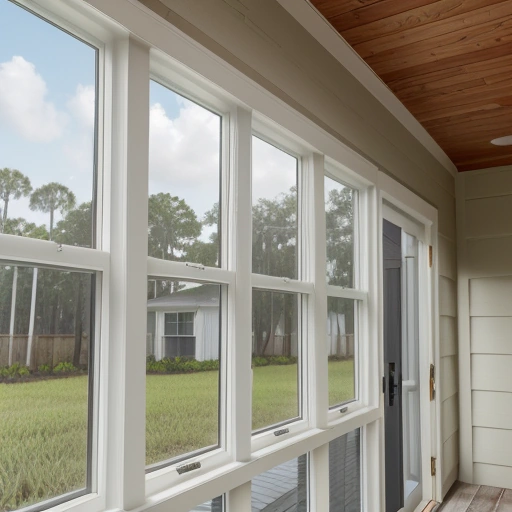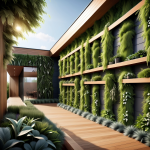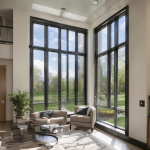Why You Should Install New Windows and Siding in Homes in High-Humidity Areas of Florida
The Silent Threat to Florida Homes: Humidity’s Impact
Florida’s allure lies in its sun-kissed beaches and vibrant landscapes. However, the state’s high humidity poses a significant threat to Florida homes, silently wreaking havoc on windows and siding. Beyond aesthetics, compromised building materials can lead to structural damage, health concerns, and soaring energy bills. This article delves into why investing in new windows and siding is not merely an upgrade but a necessity for Florida homeowners seeking longevity, resilience, and a healthy living environment.
The relentless humidity, often exceeding 70%, creates a breeding ground for mold and mildew, which can compromise indoor air quality and trigger respiratory issues, making moisture resistance a top priority for any home improvement project. Consider, for example, the plight of homeowners in coastal communities like Miami or Tampa, where the combination of salt air and constant moisture accelerates the deterioration of traditional building materials. Wood siding, a common feature in older Florida homes, becomes particularly vulnerable, requiring frequent repairs and painting to prevent rot and insect infestation.
Similarly, outdated windows with single-pane glass offer little resistance to heat transfer, forcing HVAC systems to work overtime and driving up energy costs. Investing in impact-resistant windows and durable siding materials like fiber cement siding or high-quality vinyl siding becomes a proactive measure to safeguard property value and ensure long-term comfort. Furthermore, the impact of damaged windows and siding extends beyond mere inconvenience; it directly affects Florida real estate values. A home with visible signs of water damage, peeling paint, or rotting wood will undoubtedly fetch a lower price than a well-maintained property with modern, energy-efficient upgrades. Potential buyers are increasingly aware of the long-term costs associated with neglected maintenance, making window replacement and siding installation key selling points. By prioritizing these home improvement projects, homeowners can not only enhance their living environment but also significantly increase their property’s market appeal, making it a wise investment for the future.
Combating Moisture: Choosing the Right Materials
Moisture represents a persistent threat to the structural integrity of Florida homes, especially those reliant on traditional building materials. Wood siding, a common choice in older construction, is particularly vulnerable in high-humidity environments. The combination of heat and moisture fosters rot, warping, and provides an ideal habitat for wood-boring insects like termites, leading to potentially extensive and costly damage. Similarly, outdated windows, often featuring single-pane glass and compromised seals, act as entry points for moisture.
This intrusion results in condensation, fostering mold and mildew growth, which not only degrades the window frames and surrounding structures but also introduces harmful allergens into the home’s air supply. Addressing these vulnerabilities through strategic window replacement and siding installation is critical for preserving the value and health of Florida real estate. The ramifications of moisture damage extend beyond mere aesthetics; they directly impact energy efficiency and indoor air quality. Waterlogged siding loses its insulating properties, forcing HVAC systems to work harder to maintain a comfortable indoor temperature.
This increased strain translates to higher energy bills, a significant concern for Florida homeowners facing scorching summers and, increasingly, more humid winters. Furthermore, mold and mildew growth, fueled by moisture penetration, release spores into the air, exacerbating respiratory issues and potentially triggering allergic reactions. Investing in moisture-resistant building materials, such as fiber cement siding or vinyl siding, and energy-efficient windows with advanced sealing technologies directly addresses these concerns, contributing to a healthier and more cost-effective living environment.
Selecting the appropriate materials is paramount when undertaking home improvement projects in Florida’s challenging climate. Fiber cement siding, like James Hardie, offers superior moisture resistance compared to traditional wood, effectively preventing rot and warping. Vinyl siding presents another durable and water-resistant alternative, often favored for its low maintenance requirements. For window replacement, options like impact-resistant windows with Low-E glass not only withstand storm damage but also enhance energy efficiency by reducing heat transfer. These modern materials are engineered to combat the specific challenges posed by Florida’s high humidity and intense weather, offering long-term protection and peace of mind for homeowners. By prioritizing moisture resistance and energy efficiency in siding and window choices, homeowners can significantly enhance their property’s value and resilience in the Florida real estate market.
Fiber Cement vs. Vinyl Siding: A Complete Cost and Durability Analysis
Fiber cement siding, exemplified by brands like James Hardie, has ascended to an industry benchmark, particularly for Florida homes, due to its superior moisture resistance, impressive durability, and diverse aesthetic possibilities. Unlike traditional wood siding, fiber cement is impervious to rot and warping, providing long-term protection against the relentless Florida elements. This is a critical advantage in regions plagued by high humidity, where wood-based products are prone to rapid degradation, leading to costly repairs and potential structural issues.
For homeowners prioritizing longevity and minimal upkeep, fiber cement represents a sound investment in their property’s future, bolstering both its curb appeal and its resilience against the environmental challenges unique to Florida real estate. Vinyl siding presents another compelling option, celebrated for its exceptional water resistance and minimal maintenance requirements. Its affordability and ease of installation make it a popular choice for homeowners seeking a cost-effective solution to protect their homes from moisture damage. While vinyl may not possess the same level of robustness as fiber cement in terms of impact resistance, advancements in vinyl siding technology have significantly improved its durability and aesthetic appeal.
For instance, insulated vinyl siding can further enhance a home’s energy efficiency, contributing to lower utility bills and a more comfortable living environment. Ultimately, the selection between fiber cement and vinyl siding hinges on a homeowner’s specific budget, aesthetic preferences, and long-term performance expectations. When it comes to window replacement, prioritizing energy efficiency is paramount for Florida homeowners battling high humidity and intense heat. Look for windows featuring insulated frames and Low-E glass, which work synergistically to minimize condensation and heat transfer.
Low-E coatings reflect radiant heat, keeping interiors cooler during the scorching summer months and warmer during the occasional cool spells. Argon or krypton gas fills between the panes of glass further enhance insulation, reducing energy consumption and lowering monthly utility bills. Impact-resistant windows, while offering crucial storm protection, can also incorporate these energy-efficient features, providing a comprehensive solution for Florida homes seeking both resilience and cost savings. Investing in high-performance windows is a strategic home improvement that directly translates to increased comfort, reduced energy expenses, and enhanced property value in the competitive Florida real estate market.
Energy-Efficient Windows: How Modern Glass Technology Saves You Money
Florida’s intense heat and humidity place a significant burden on HVAC systems, invariably leading to increased energy consumption for Florida homes. Older windows and siding are often the culprits, lacking adequate insulation and allowing heat to relentlessly penetrate during the sweltering summer months, while simultaneously permitting precious conditioned air to escape during the cooler winter. Energy-efficient windows, equipped with Low-E glass coatings and insulated frames, are a game-changer. These windows significantly reduce heat transfer, reflecting solar radiation away from the home in the summer and retaining warmth inside during the winter, directly translating to lower energy bills and a more consistently comfortable living environment.
Similarly, insulated siding provides an invaluable additional layer of thermal protection, further minimizing energy loss. Beyond just the glass itself, the frame material plays a crucial role in energy efficiency. Vinyl frames, for instance, offer excellent insulation properties and are resistant to moisture, making them a popular choice for Florida’s humid climate. Fiber cement siding, while primarily known for its durability and moisture resistance, can also contribute to energy savings when installed with an insulating underlayment.
Consider, for example, a homeowner in Orlando who replaced their old single-pane windows with energy-efficient, double-paned windows. They reported a nearly 30% reduction in their monthly energy bills during peak summer months, a testament to the tangible benefits of modern window technology. This is a prime example of a worthwhile home improvement that boosts Florida real estate value. Furthermore, the design and installation of energy-efficient windows and siding can significantly impact a home’s aesthetic appeal.
Modern windows come in a variety of styles and colors, allowing homeowners to enhance their home’s exterior design while simultaneously improving energy efficiency. Siding options, ranging from traditional vinyl to durable fiber cement, offer a wide range of textures and colors to complement any architectural style. By carefully selecting energy-efficient windows and siding that align with their aesthetic preferences, homeowners can increase their property value and curb appeal, making their home more attractive to potential buyers. Investing in energy efficiency is not just about saving money; it’s about creating a more comfortable, sustainable, and valuable home.
Impact-Resistant Windows: Worth the Investment in Storm-Prone Areas
Florida’s vulnerability to hurricanes and severe storms elevates impact resistance to a critical factor in window and siding selection. Impact-resistant windows are engineered to endure extreme wind pressures and collisions with airborne debris, safeguarding Florida homes from structural compromise and water infiltration. This is particularly crucial in coastal areas where storm surges can exacerbate damage. Opting for impact-resistant windows not only fortifies the building envelope but also mitigates the risk of interior water damage, which can lead to costly repairs and mold remediation – a significant concern given Florida’s high humidity.
For Florida real estate, this translates to enhanced property value and reduced long-term maintenance costs, appealing to discerning homebuyers. Beyond windows, the choice of siding material significantly influences a home’s resilience. While traditional wood siding is aesthetically pleasing, it lacks inherent impact resistance and is prone to damage from flying debris during storms. Vinyl siding offers a degree of protection, but fiber cement siding, such as James Hardie, stands out for its superior impact resistance and durability.
Fiber cement’s composition allows it to withstand significant impacts without cracking or shattering, providing an additional layer of defense against storm damage. This robustness is a key selling point for home improvement projects focused on storm protection and long-term value, aligning with the priorities of Florida homeowners seeking peace of mind. Investing in impact-resistant windows and durable siding materials translates to tangible financial benefits for Florida homeowners. While the initial cost may be higher, these upgrades often qualify for insurance premium discounts, reflecting the reduced risk of storm-related damage. Furthermore, impact-resistant windows contribute to energy efficiency by minimizing air leakage, thereby lowering heating and cooling costs. This dual benefit – storm protection and energy savings – makes impact-resistant windows a smart investment for homeowners looking to enhance their property’s value, reduce their environmental footprint, and ensure long-term resilience against Florida’s challenging climate. The integration of energy-efficient and impact-resistant features also aligns with contemporary exterior design trends that prioritize both aesthetics and functionality.
Window Replacement ROI: Understanding Your Return on Investment
Installing new windows and siding is a significant investment that can yield a substantial return on investment (ROI). In addition to lower energy bills and reduced maintenance costs, upgrading the exterior of Florida homes can significantly enhance their curb appeal and market value. Potential buyers are often drawn to homes with modern, well-maintained exteriors, making it easier to sell the property for a higher price. Consider the long-term benefits and increased property value when evaluating the cost of these upgrades, especially given the unique challenges posed by Florida’s climate.
For example, a home with new, energy-efficient windows and fiber cement siding signals to potential buyers that the property is well-protected against moisture and the elements, reducing their future maintenance concerns. The ROI on window replacement and siding installation extends beyond aesthetics. Energy-efficient upgrades directly translate to savings on monthly utility bills, a major selling point in Florida’s hot and humid climate. According to a recent study by Remodeling Magazine, homeowners in the South Atlantic region can recoup a significant portion of their investment in window replacement through increased home value.
Furthermore, impact-resistant windows, while initially more expensive, can lower insurance premiums in storm-prone areas, adding another layer of financial benefit. When evaluating siding options, consider that fiber cement siding, known for its durability and moisture resistance, often commands a higher resale value compared to traditional wood siding that is prone to rot and insect infestation in high humidity environments. Moreover, the enhanced curb appeal resulting from new siding and windows can dramatically impact a home’s perceived value in the competitive Florida real estate market.
A fresh, modern exterior creates a positive first impression, attracting more potential buyers and potentially leading to higher offers. Real estate agents often advise homeowners to prioritize exterior upgrades before listing their properties, recognizing the significant influence these improvements have on buyer perception. For instance, replacing old, drafty windows with energy-efficient, impact-resistant models not only improves the home’s appearance but also communicates a commitment to quality and long-term maintenance, reassuring buyers about the property’s overall condition. Investing in siding installation, particularly with durable and aesthetically pleasing materials like fiber cement or vinyl, can transform a tired-looking house into a desirable home, ultimately boosting its market value and accelerating the sales process.
Professional vs DIY Exterior Upgrades
Proper installation is just as important as choosing the right materials when upgrading Florida homes. While high-quality fiber cement siding or energy-efficient, impact-resistant windows offer inherent benefits, substandard siding installation or window replacement can negate these advantages, leading to premature failure and costly repairs. Hiring a qualified and experienced contractor is essential to ensure that windows and siding are installed correctly and according to manufacturer specifications, particularly crucial in regions prone to extreme weather. A professional installation will prevent water intrusion, ensure proper insulation, and maximize the lifespan of the materials, safeguarding your investment and maintaining the structural integrity of your Florida real estate.
When selecting a contractor for siding installation or window replacement, homeowners should prioritize experience and expertise specific to Florida’s climate and building codes. Obtain multiple quotes, but don’t base your decision solely on price. Check references, review online testimonials, and verify that the contractor is licensed and insured. A reputable contractor will possess a deep understanding of moisture resistance techniques, proper flashing methods, and the unique challenges posed by high humidity. They should also be well-versed in energy efficiency best practices, ensuring that the installation minimizes thermal bridging and air leakage, contributing to lower energy bills.
For example, improper flashing around windows can lead to significant water damage over time, even with high-quality impact-resistant windows. DIY siding installation or window replacement might seem appealing as a cost-saving measure, but it often leads to long-term problems, especially in Florida homes. Without the proper tools, knowledge, and experience, homeowners risk improper sealing, incorrect fastening, and compromised weather resistance. These mistakes can result in water damage, mold growth, and reduced energy efficiency, ultimately costing more to repair than the initial savings.
Moreover, incorrect installation can void manufacturer warranties, leaving homeowners liable for any defects or failures. Investing in professional siding installation and window replacement ensures that the job is done right the first time, providing peace of mind and protecting your home from the elements. This is especially true when dealing with specialized materials like fiber cement siding, which requires specific cutting and installation techniques to maintain its integrity and aesthetic appeal. Furthermore, professional contractors bring valuable insights into exterior design and can advise on optimal material choices and installation techniques to enhance curb appeal and property value.
They can assess the existing structure, identify potential problems, and recommend solutions that align with your aesthetic preferences and budget. In the competitive Florida real estate market, a well-executed siding and window upgrade can significantly increase a home’s marketability and resale value. For example, a cohesive exterior design featuring fiber cement siding and energy-efficient windows can attract potential buyers seeking a move-in-ready home with low maintenance and energy costs. Therefore, while the upfront cost of professional installation may be higher, the long-term benefits in terms of durability, energy efficiency, and property value make it a worthwhile investment for Florida homeowners.
Investing in Your Home’s Future: A Necessary Upgrade
In the battle against Florida’s relentless humidity, new windows and siding are not just upgrades – they are essential investments in the health, safety, and longevity of your Florida homes. By choosing moisture-resistant materials, prioritizing energy efficiency, and ensuring professional siding installation and window replacement, homeowners can protect their properties from the damaging effects of high humidity, reduce energy bills, and enhance their overall quality of life. Don’t underestimate the power of a well-protected home in the Sunshine State; it’s a cornerstone of Florida real estate value and comfortable living.
Consider the tangible benefits: upgrading to fiber cement siding, renowned for its moisture resistance, prevents costly repairs associated with rot and insect infestation common in wood siding. Simultaneously, energy-efficient windows with Low-E glass minimize heat transfer, directly impacting your monthly energy bills and reducing the strain on your HVAC system. These improvements not only safeguard your home against the elements but also contribute to a more sustainable and comfortable living environment. For example, a homeowner in Miami-Dade County saw a 30% reduction in their energy bills after installing energy-efficient windows and fiber cement siding, according to a recent case study by the Florida Energy Efficiency Alliance.
Furthermore, investing in impact-resistant windows and siding provides crucial storm protection, a significant factor for Florida homeowners. These upgrades offer peace of mind during hurricane season, mitigating potential damage from high winds and flying debris. Beyond the immediate protection, impact-resistant features can also lead to lower insurance premiums, adding another layer of financial benefit to the investment. From an exterior design perspective, both vinyl siding and fiber cement siding offer a range of aesthetic options to enhance curb appeal, increasing the home’s market value and making it more attractive to potential buyers. Ultimately, window replacement and siding installation represent a strategic home improvement decision that yields both immediate and long-term returns.


